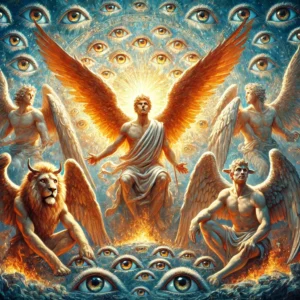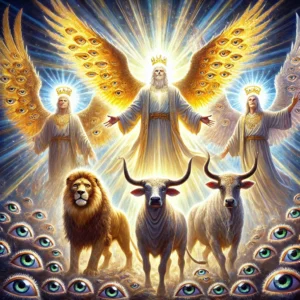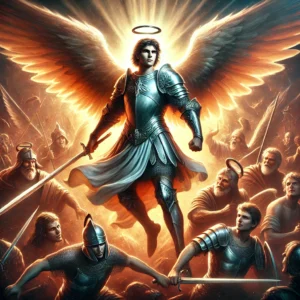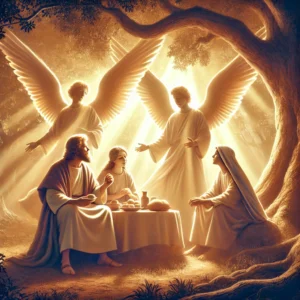Angels in the Bible are often quite different from the common depictions seen in art, media, and pop culture. Many of us picture angels as serene, human-like figures with delicate wings and glowing halos, but biblically accurate angels are often described in ways that are much more striking, terrifying, and awe-inspiring. Here’s a deeper dive into what angels really look like according to the Bible.
1. Angels as Heavenly Messengers

The word “angel” itself comes from the Greek word angelos, meaning “messenger.” Angels in the Bible are primarily messengers sent by God to deliver His will. While their appearance can vary depending on the context, they are almost always associated with power, awe, and sometimes fear. Let’s explore some of the key biblical descriptions.
2. Seraphim: The Fiery Angels

One of the most dramatic depictions of angels is the seraphim, as described in Isaiah 6:1-7. These angels are associated with fire and worship:
- Appearance: Seraphim are described as having six wings. With two wings, they cover their faces; with two, they cover their feet; and with two, they fly.
- Role: They are seen praising God constantly, saying, “Holy, holy, holy is the Lord of hosts; the whole earth is full of His glory” (Isaiah 6:3).
- Fiery Nature: The word seraphim comes from the Hebrew word saraph, which means “to burn.” This implies that seraphim are fiery and powerful beings, not the gentle, serene beings often depicted in art.
3. Cherubim: The Guardians of God’s Presence
Another prominent type of angel are the cherubim. These beings are not the adorable, childlike figures seen in paintings but rather formidable, awe-inspiring creatures.
- Appearance: Cherubim are described in Ezekiel 10 as having four faces: that of a man, a lion, an ox, and an eagle. They have four wings and feet like a calf’s that shine like burnished bronze.
- Role: In the Bible, cherubim serve as guardians of God’s glory and His sacred spaces. They are placed at the entrance of the Garden of Eden to guard the way to the Tree of Life after Adam and Eve’s fall (Genesis 3:24), and they were placed on the mercy seat of the Ark of the Covenant (Exodus 25:18-22).
4. The “Living Creatures” of Revelation

In the book of Revelation, the apostle John describes a group of angels known as the “living creatures” or “beasts”, which are closely related to the cherubim.
- Appearance: These creatures have six wings (like seraphim) and are full of eyes all around, symbolizing their awareness and vigilance. They have faces that resemble a lion, an ox, a man, and an eagle (Revelation 4:6-8).
- Role: They continually worship God before His throne, declaring, “Holy, holy, holy is the Lord God Almighty, who was, and is, and is to come” (Revelation 4:8).
5. Archangels: Powerful Messengers

In the Bible, the archangel Michael is specifically mentioned as a powerful, warrior-like angel. Archangels, while not described in as much detail as the seraphim or cherubim, are leaders of the heavenly army.
- Michael’s Appearance: Although not much is said about Michael’s physical appearance in the Bible, in Jude 1:9, we see that he engages in combat with Satan. The strength of Michael suggests that he is not a fragile, gentle figure but a mighty warrior.
- Role: Archangels act as leaders of God’s armies, fighting against the forces of evil, as seen in Michael’s role in Revelation 12:7-9, where he leads a heavenly army to battle Satan and his angels.
6. Angels in Human-Like Forms: The “Men” Who Visit Abraham

While most angels in the Bible are described as terrifying or awe-inspiring creatures, there are times when angels appear in human form. This is particularly seen in the Book of Genesis, where angels visit Abraham and Lot.
- Genesis 18: The three men who visit Abraham are described as appearing as human beings, although one is later revealed to be the Lord Himself, while the others are angels. These angels looked human but had the power to perform miracles and carry out God’s will.
- Genesis 19: The angels who visit Lot in Sodom are also described as looking like men. However, their actions demonstrate their divine power, as they rescue Lot and his family from the destruction of the city.
7. What About “Angels with Wings”?

In many biblical descriptions, wings are associated with angels, but it’s not a universal feature. For example:
- Isaiah 6 (Seraphim) and Ezekiel 10 (Cherubim) clearly depict angels with wings.
- Revelation 4 describes the living creatures as having wings.
However, many angels in the Bible (like those who visited Abraham and Lot) appear without wings but still perform miraculous tasks. The idea of angels having wings comes from these descriptions, but not all angels in Scripture are depicted with them.
8. Common Themes: Awe, Fear, and Power
- Powerful and Glorious: Biblically, angels are often seen as overwhelmingly glorious beings, whose presence inspires fear or awe in humans. When angels appear in the Bible, people often fall to the ground in fear (Revelation 1:17, Matthew 28:4).
- Warriors of God: Many of the most powerful angels, like Michael, are described as warriors who fight in God’s service against evil forces (Daniel 10:13, Revelation 12:7-9). This warrior-like aspect of angels is far removed from the peaceful, passive figures often seen in modern depictions.
- Messengers of God: Though angels are powerful, they also serve as messengers or servants of God. They deliver divine messages, as seen in the angelic appearances to Mary (announcing the birth of Jesus) and to Joseph (guiding him through dreams).
9. Conclusion: Angels in Their True Form
Biblically accurate angels are not the gentle, glowing, human-like beings with soft, delicate wings that we often see in popular culture. Instead, they are awe-inspiring, often terrifying, and majestic creatures that reflect the majesty and power of God. Whether as seraphim, cherubim, or living creatures, angels in the Bible are mighty beings created to carry out God’s will, inspire awe, and lead in spiritual warfare.
Their appearances may vary—sometimes fiery, sometimes human-like, but always filled with divine purpose and glory. The next time you think of angels, remember that these beings are far more complex, majestic, and fearsome than we often imagine in our modern depictions.
